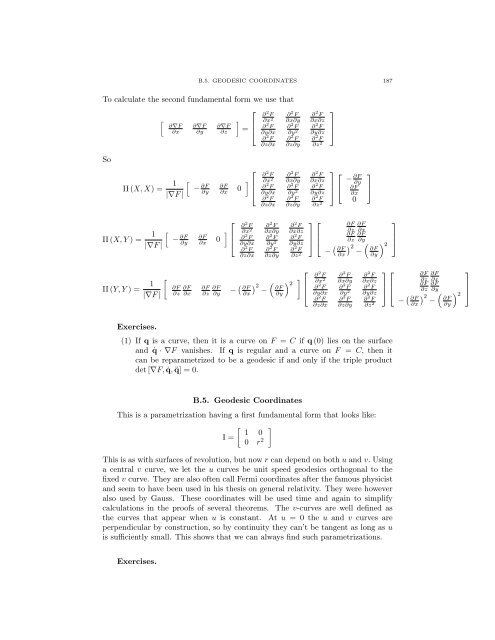Lecture Notes for 120 - UCLA Department of Mathematics
Lecture Notes for 120 - UCLA Department of Mathematics
Lecture Notes for 120 - UCLA Department of Mathematics
You also want an ePaper? Increase the reach of your titles
YUMPU automatically turns print PDFs into web optimized ePapers that Google loves.
B.5. GEODESIC COORDINATES 187<br />
To calculate the second fundamental <strong>for</strong>m we use that<br />
2<br />
@ 2 F<br />
i @x<br />
6<br />
2<br />
@<br />
= 4<br />
2 F<br />
h<br />
@rF<br />
@x<br />
@rF<br />
@y<br />
@rF<br />
@z<br />
@y@x<br />
@ 2 F<br />
@z@x<br />
@ 2 F<br />
@x@y<br />
@ 2 F<br />
@y 2<br />
@ 2 F<br />
@z@y<br />
3<br />
@ 2 F<br />
@x@z<br />
@ 2 F 7<br />
@y@z 5<br />
@ 2 F<br />
@z 2<br />
So<br />
II (X, X) = 1 h<br />
|rF |<br />
@F<br />
@y<br />
@F<br />
@x<br />
0<br />
2<br />
i<br />
6<br />
4<br />
@ 2 F<br />
@x 2<br />
@ 2 F<br />
@y@x<br />
@ 2 F<br />
@z@x<br />
@ 2 F<br />
@x@y<br />
@ 2 F<br />
@y 2<br />
@ 2 F<br />
@z@y<br />
3<br />
@ 2 F<br />
@x@z<br />
@ 2 F 7<br />
@y@z 5<br />
@ 2 F<br />
@z 2<br />
2<br />
4<br />
@y<br />
@F<br />
@x<br />
0<br />
5<br />
@F<br />
3<br />
II (X, Y )= 1 h<br />
|rF |<br />
@F<br />
@y<br />
@F<br />
@x<br />
0<br />
2<br />
i<br />
6<br />
4<br />
@ 2 F<br />
@x 2<br />
@ 2 F<br />
@y@x<br />
@ 2 F<br />
@z@x<br />
@ 2 F<br />
@x@y<br />
@ 2 F<br />
@y 2<br />
@ 2 F<br />
@z@y<br />
3<br />
@ 2 F<br />
@x@z<br />
@ 2 F 7<br />
@y@z 5<br />
@ 2 F<br />
@z 2<br />
2<br />
6<br />
4<br />
@F @F<br />
@z @x<br />
@F @F<br />
@z @y<br />
@F 2<br />
@x<br />
⇣<br />
@F<br />
@y<br />
3<br />
7<br />
⌘ 2<br />
5<br />
II (Y,Y )= 1 apple<br />
|rF |<br />
@F @F<br />
@z @x<br />
@F @F<br />
@z @y<br />
@F<br />
@x<br />
2<br />
⇣<br />
@F<br />
@y<br />
⌘ 2<br />
2<br />
6<br />
4<br />
@ 2 F<br />
@x 2<br />
@ 2 F<br />
@y@x<br />
@ 2 F<br />
@z@x<br />
@ 2 F<br />
@x@y<br />
@ 2 F<br />
@y 2<br />
@ 2 F<br />
@z@y<br />
3<br />
@ 2 F<br />
@x@z<br />
@ 2 F 7<br />
@y@z 5<br />
@ 2 F<br />
@z 2<br />
2<br />
6<br />
4<br />
@F @F<br />
@z @x<br />
@F @F<br />
@z @y<br />
@F 2<br />
@x<br />
⇣<br />
@F<br />
@y<br />
3<br />
7<br />
⌘ 2<br />
5<br />
Exercises.<br />
(1) If q is a curve, then it is a curve on F = C if q (0) lies on the surface<br />
and ˙q ·rF vanishes. If q is regular and a curve on F = C, then it<br />
can be reparametrized to be a geodesic if and only if the triple product<br />
det [rF, ˙q, ¨q] =0.<br />
B.5. Geodesic Coordinates<br />
This is a parametrization having a first fundamental <strong>for</strong>m that looks like:<br />
apple 1 0<br />
I=<br />
0 r 2<br />
This is as with surfaces <strong>of</strong> revolution, but now r can depend on both u and v. Using<br />
acentralv curve, we let the u curves be unit speed geodesics orthogonal to the<br />
fixed v curve. They are also <strong>of</strong>ten call Fermi coordinates after the famous physicist<br />
and seem to have been used in his thesis on general relativity. They were however<br />
also used by Gauss. These coordinates will be used time and again to simplify<br />
calculations in the pro<strong>of</strong>s <strong>of</strong> several theorems. The v-curves are well defined as<br />
the curves that appear when u is constant. At u = 0 the u and v curves are<br />
perpendicular by construction, so by continuity they can’t be tangent as long as u<br />
is sufficiently small. This shows that we can always find such parametrizations.<br />
Exercises.
















